You are here
Home ›Species interactions and habitat associations of birds inhabiting urban areas of Sydney
Aim of project
The aim of this first project conducted under the Birds in Backyards program was to describe the distribution of 20 common bird species and relate these to characteristics of Sydney's backyards. A second aim was to investigate any associations between particular bird species, especially the Pied Currawong and Noisy Miner.
Participants
The study was undertaken by Holly Parsons and Kristine French from the University of Wollongong, along with Richard Major from the Australian Museum and around 900 volunteer bird watchers.
Methods
Twenty species were targeted for study, including seven species of small bird (Willie Wagtail, Silvereye, Red-browed Finch, Superb Fairy-wren, Eastern Spinebill, New Holland Honeyeater and Eastern Yellow Robin), one introduced species (Common Myna), as well as the Pied Currawong and Noisy Miner. Nine hundred volunteers recorded which of these species visited their gardens each day, for seven days in November, 2000, and of these, seven hundred and twenty-one data sets were used by the researchers to calculate results . Volunteers also provided information on the structure of their gardens (including the percentage cover of grass, shrubs and trees), and whether they provided food for pets and wild birds.
Results
The Noisy Miner, Pied Currawong and Common Myna were each present in over 60 % of gardens. Each small bird species was present in fewer than 40% of gardens. All small birds were significantly less common in gardens in which Noisy Miners were common, and the Silvereye was less common in gardens with Pied Currawongs. None of the species of small birds was negatively associated with Common Mynas.
Table: Percentage of gardens in which small birds were recorded, separated into gardens in which Noisy Miners were present and those in which they were absent.
| Small Bird Species | Noisy Miners Absent | Noisy Miners Present |
|---|---|---|
| New Holland Honeyeater | 42 | 12.2 |
| Eastern Spinebill | 37.6 | 12.7 |
| Silvereye | 43.7 | 18.1 |
| Eastern Yellow Robin | 9.5 | 4.7 |
| Red-browed Finch | 15.6 | 9.4 |
| Superb Fairy-wren | 30.8 | 19.7 |
| Willie Wagtail | 47.1 | 29.6 |
Eastern Spinebills, Eastern Yellow Robins and Superb Fairy-wrens visited gardens composed of at least 50% native vegetation more frequently than gardens that had mostly exotic vegetation. Gardens that had more trees were more likely to attract Pied Currawongs, Eastern Yellow Robins and Eastern Spinebills than gardens with sparser vegetation. Conversely, both the Common Myna and the Willie Wagtail were more likely to visit gardens with a greater cover of lawn.
More birds were recorded in gardens where seed was provided, but the only small bird to benefit from seed was the Red-browed Finch. Although more birds were recorded in gardens in which meat was provided, there were significantly fewer small birds in these gardens.
Conclusions
This study supports the idea that the small birds are the ones that are declining in cities, as they were all less abundant than the larger ones. The most striking feature of gardens in which small birds were present was that Noisy Miners were absent. Avoiding feeding birds with meat, planting native plants, and including more trees in gardens, are activities that might favour the small birds. However, finding a way of making gardens less suitable for Noisy Miners would seem to be the highest priority for maintaining small birds in cities.
Related information
- Birds behaving badly: Noisy Miner article
- University of Wollongong School of Biological Sciences: Staff - Kristine French
- Australian Museum Research: Staff - Richard Major











